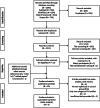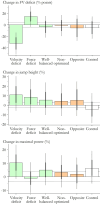Force-velocity profile based training to improve vertical jump performance a systematic review and meta analysis
- PMID: 40593873
- PMCID: PMC12217789
- DOI: 10.1038/s41598-025-00870-1
Force-velocity profile based training to improve vertical jump performance a systematic review and meta analysis
Abstract
This systematic review and meta-analysis evaluated the effects of training optimized to correct deficits in vertical force-velocity (FV) profiles compared to non-optimized training. Outcomes included changes in the FV profile, vertical jump height, and maximal power. Searches followed PRISMA guidelines and were conducted in PubMed, Web of Science, SPORTDiscus, and Scopus. Study quality was assessed using the PEDro scale. As of March 2025, ten studies were identified; four were eligible for meta-analysis. Individually optimized FV-based training partially corrected a force deficit, fully corrected a velocity deficit, and had little effect on an already optimum FV profile. Effects on maximal power were small to trivial and often unclear when compared with non-optimized training. There were small-moderate improvements in jump height with optimized training, but these gains were comparable to non-optimized training. Heterogeneity was small to moderate, and methodological shortcomings were noted in all studies, including those excluded from the meta-analysis. Overall, it remains unclear if FV-profile-based training outperforms standard approaches. Labeling training "optimized" or "non-optimized" may induce placebo or nocebo effects, underscoring the need for blinded, randomized controlled trials.
Keywords: Countermovement jump; Squat jump; Strength and power training; Testing of athletic performance.
© 2025. The Author(s).
Conflict of interest statement
Declarations. Competing interests: The authors declare no competing interests.
Figures


Similar articles
-
The Effects of Strength, Plyometric and Combined Training on Strength, Power and Speed Characteristics in High-Level, Highly Trained Male Youth Soccer Players: A Systematic Review and Meta-Analysis.Sports Med. 2024 Mar;54(3):623-643. doi: 10.1007/s40279-023-01944-8. Epub 2023 Oct 28. Sports Med. 2024. PMID: 37897637 Free PMC article.
-
Systemic pharmacological treatments for chronic plaque psoriasis: a network meta-analysis.Cochrane Database Syst Rev. 2021 Apr 19;4(4):CD011535. doi: 10.1002/14651858.CD011535.pub4. Cochrane Database Syst Rev. 2021. Update in: Cochrane Database Syst Rev. 2022 May 23;5:CD011535. doi: 10.1002/14651858.CD011535.pub5. PMID: 33871055 Free PMC article. Updated.
-
Effect of Plyometric Training on Vertical Jump Performance in Female Athletes: A Systematic Review and Meta-Analysis.Sports Med. 2017 May;47(5):975-986. doi: 10.1007/s40279-016-0634-6. Sports Med. 2017. PMID: 27704484
-
Systemic pharmacological treatments for chronic plaque psoriasis: a network meta-analysis.Cochrane Database Syst Rev. 2017 Dec 22;12(12):CD011535. doi: 10.1002/14651858.CD011535.pub2. Cochrane Database Syst Rev. 2017. Update in: Cochrane Database Syst Rev. 2020 Jan 9;1:CD011535. doi: 10.1002/14651858.CD011535.pub3. PMID: 29271481 Free PMC article. Updated.
-
Physical exercise training interventions for children and young adults during and after treatment for childhood cancer.Cochrane Database Syst Rev. 2016 Mar 31;3(3):CD008796. doi: 10.1002/14651858.CD008796.pub3. Cochrane Database Syst Rev. 2016. PMID: 27030386 Free PMC article.
References
-
- Morin, J. B. & Samozino, P. Interpreting power-force-velocity profiles for individualized and specific training. Int. J. Sports Physiol. Perform.11, 267–272. 10.1123/ijspp.2015-0638 (2016). - PubMed
-
- Samozino, P., Morin, J. B., Hintzy, F. & Belli, A. A simple method for measuring force, velocity and power output during squat jump. J. Biomech.41, 2940–2945. 10.1016/j.jbiomech.2008.07.028 (2008). - PubMed
-
- Samozino, P., Morin, J. B., Hintzy, F. & Belli, A. Jumping ability: a theoretical integrative approach. J. Theoret. Biol.264, 11–18. 10.1016/j.jtbi.2010.01.021 (2010). - PubMed
-
- Jaric, S. Force-velocity relationship of muscles performing multi-joint maximum performance tasks. Int. J. Sports Med.36, 699–704. 10.1055/s-0035-1547283 (2015). - PubMed
-
- Samozino, P. Biomechanics of training and testing: Innovative concepts and simple field methods Vol. 4, 65–96 (Springer, 2018).
Publication types
MeSH terms
LinkOut - more resources
Full Text Sources
Research Materials

